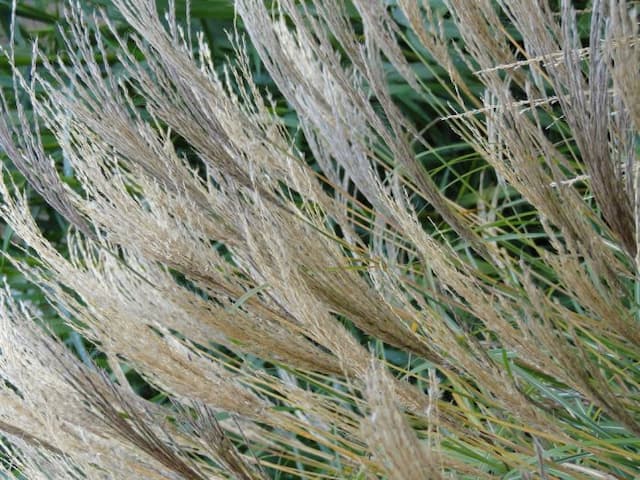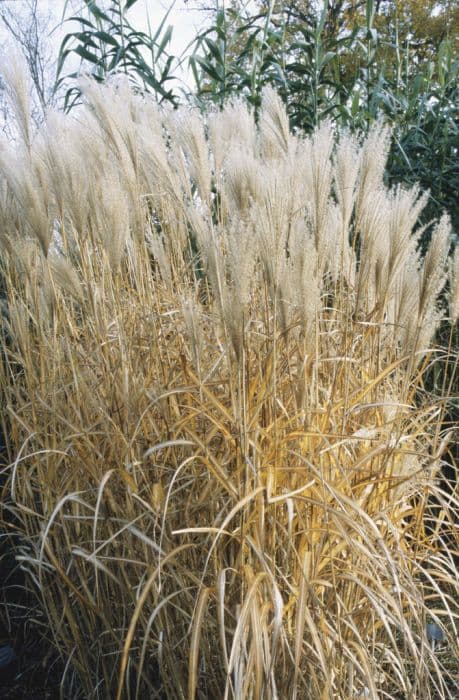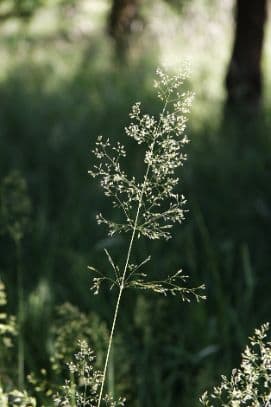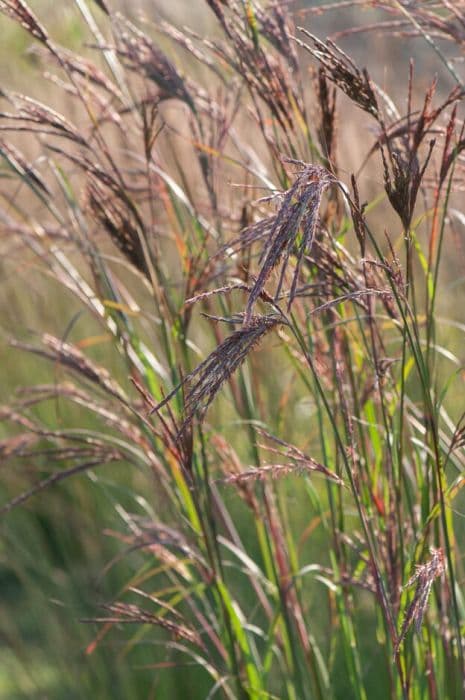Purple Moor Grass Molinia caerulea subsp. caerulea 'Poul Petersen'











ABOUT
Molinia caerulea subsp. caerulea 'Poul Petersen', commonly known as purple moor grass, is a perennial grass notable for its graceful form and beautiful coloration. This variety features narrow, linear leaves that emerge with a green color and transition through shades of purple and orange as the seasons progress, adding visual interest to garden spaces throughout the year. The leaves of the purple moor grass are typically slender and may exhibit a slightly arching habit, giving the clumps a soft, tufted look. This texture adds a fine, delicate quality to the landscape and allows for gentle movement in breezes. With a change in seasons, especially in autumn, the foliage often takes on more vibrant warm tones before eventually turning to shades of brown, which can provide winter interest. During the flowering period, the purple moor grass produces airy, delicate flower spikes that rise above the foliage. These flowers are held on slender stems and can wave elegantly in the wind, contributing to the plant's overall ethereal and light appearance. The color of the flower spikes often complements the foliage, with subtle hues that do not overpower the grass's natural charm. After the blooming period, the flowers turn into seed heads, which remain attractive even as they dry on the plant. Purple moor grass is appreciated for its low-maintenance nature and its ability to blend seamlessly into naturalistic plantings, meadow gardens, or as an accent in more formal garden designs. The plant's texture and seasonal color change make it a versatile choice for creating visually engaging landscapes with a focus on foliage and movement.
About this plant
 Names
NamesFamily
Poaceae
Synonyms
Purple Moor Grass, Moor Grass
Common names
Aira caerulea, Molinia caerulea, Molinia caerulea var. arundinacea, Molinia caerulea var. caerulea.
 Toxicity
ToxicityTo humans
Molinia caerulea, commonly known as Purple Moor Grass, is not generally considered toxic to humans. There are no well-documented cases of poisoning from ingesting this plant, and it is not usually listed as a concern for human poisoning. Therefore, while it is always wise to avoid ingesting plants that are not known to be edible, Purple Moor Grass does not have a recognized toxic effect on humans if ingested.
To pets
Purple Moor Grass, the common name for Molinia caerulea, is generally not considered to be toxic to pets either. Similar to its effects on humans, there is no widespread evidence to suggest that ingestion of this plant by pets leads to poisoning. It is not commonly listed among plants that pose a risk of toxicity to animals. While individual pets might have unique sensitivities or allergic reactions, Purple Moor Grass is not known to cause specific symptoms of poisoning or to be hazardous to pets if they happen to consume it.
 Characteristics
CharacteristicsLife cycle
Perennials
Foliage type
Deciduous
Color of leaves
Green
Height
4 feet (1.2 meters)
Spread
2 feet (0.6 meters)
Plant type
Grass
Hardiness zones
5
Native area
Europe
Benefits
 General Benefits
General Benefits- Landscape Aesthetics: Adds texture and color to gardens throughout the year with its bright green leaves in spring and summer, turning rich gold or purple in autumn.
- Wildlife Habitat: Provides shelter and food for birds and insects, making it a great choice for wildlife-friendly gardens.
- Low Maintenance: Requires minimal care once established, making it suitable for low-maintenance landscapes.
- Tolerance to Various Conditions: Adapts well to a variety of soil types and can withstand periods of drought once established.
- Erosion Control: The dense root system helps stabilize soil and prevent erosion, particularly on slopes.
- Seasonal Interest: Offers year-round visual interest with changing leaf colors and the presence of delicate flower spikes in summer.
 Medical Properties
Medical Properties- This plant is not used for medical purposes.
 Air-purifying Qualities
Air-purifying QualitiesThis plant is not specifically known for air purifying qualities.
 Other Uses
Other Uses- Molinia caerulea 'Poul Petersen' can be used as a natural dye source, providing subtle colors for textiles and wool.
- This ornamental grass is incorporated in floral arrangements and dried bouquets, adding texture and interest.
- The dried stems of Molinia caerulea 'Poul Petersen' are used in thatching roofs in some traditional building techniques.
- Fine stems from this plant are sometimes used in basket weaving for decorative detailing.
- The grass serves as material for crafting small hand-made paper due to its fibrous nature.
- In garden design, Molinia caerulea 'Poul Petersen' is used as a privacy screen when planted en masse due to its dense growth habit.
- This species can be employed in sound insulation purposes in landscaping due to its dense tussocks.
- It's used to create habitat structures for wildlife in gardens, providing shelter for insects and small mammals.
- Incorporated in natural landscaping, it helps in soil erosion control due to its extensive root system.
- Gardeners use Molinia caerulea 'Poul Petersen' to add a contrasting texture among rock gardens and along pond edges.
Interesting Facts
 Feng Shui
Feng ShuiThe Purple Moor Grass is not used in Feng Shui practice.
 Zodiac Sign Compitability
Zodiac Sign CompitabilityThe Purple Moor Grass is not used in astrology practice.
 Plant Symbolism
Plant Symbolism- Persistence: Molinia caerulea, commonly known as Purple Moor Grass, is known for its resilience and ability to thrive in difficult conditions, symbolizing persistence and endurance.
- Adaptability: As a grass that can adapt to varying environments, it represents the ability to adjust and be versatile in life's challenges.
- Grace: With its slender stems and delicate inflorescences that sway gracefully in the breeze, Purple Moor Grass symbolizes grace and elegance.
- Growth: Grasses like the Purple Moor Grass go through cycles of growth, dormancy, and rebirth, embodying the concept of personal growth and regeneration.
 Water
WaterThe common name for Molinia caerulea subsp. caerulea 'Poul Petersen' is Moor Grass. When watering Moor Grass, it's important to maintain a consistently moist soil environment without over-saturating it. During the growing season in spring and summer, water the grass once a week with approximately 1-1.5 gallons per plant, depending on the weather and soil drainage. In hotter or drier conditions, check the moisture level more frequently to ensure the soil doesn't dry out completely. Reduce watering in the fall and winter when the plant's growth slows down, but do not allow the soil to become bone dry.
 Light
LightMoor Grass thrives best in full sun to partial shade conditions. For optimum growth, plant it in a spot where it receives at least 4-6 hours of direct sunlight daily. However, Moor Grass is also adaptable to light shade, especially in regions with very hot summer weather. Avoid deep shade locations, as this can limit the plant's vigor and flowering potential.
 Temperature
TemperatureMoor Grass is a hardy plant that can tolerate a wide range of temperatures, typically between 20°F and 90°F. The ideal temperature for robust growth is between 60°F and 75°F. It can survive occasional dips below 20°F but should be protected from prolonged exposure to extreme cold to prevent root damage.
 Pruning
PruningPruning Moor Grass helps maintain its shape and encourages healthy new growth. Cut back the foliage to about 4 inches in late winter or early spring before new growth begins. This ensures that the fresh shoots are not damaged and can emerge unimpeded by dead material. Pruning is typically needed once a year, and the best time for this is just before the growing season begins.
 Cleaning
CleaningNot needed
 Soil
SoilPurple Moor Grass (Molinia caerulea 'Poul Petersen') thrives best in an organic, peat-rich soil that is well-draining. An ideal soil mix can be composed of two parts peat or sphagnum moss, one part loamy soil, and one part sand or perlite to ensure proper drainage and aeration. The preferred soil pH for Purple Moor Grass is slightly acidic to neutral, ranging from 5.5 to 7.0.
 Repotting
RepottingPurple Moor Grass, or Molinia caerulea 'Poul Petersen', generally doesn't require frequent repotting and can be done every 2-3 years. Repotting is best carried out in the late winter or early spring before new growth begins, ensuring minimal disruption to the plant.
 Humidity & Misting
Humidity & MistingPurple Moor Grass (Molinia caerulea 'Poul Petersen') does well in average humidity conditions found in outdoor environments. This plant does not have specific humidity requirements and is quite adaptable; however, it does appreciate a somewhat moist atmosphere, emulating its natural boggy habitat.
 Suitable locations
Suitable locationsIndoor
Ensure bright light, well-draining soil mix, and occasional watering.
Outdoor
Plant in full sun to light shade, provide moist soil, hardy nature.
Hardiness zone
5-9 USDA
 Life cycle
Life cycleMolinia caerulea subsp. caerulea 'Poul Petersen', commonly known as Poul Petersen's Moor Grass, begins its life cycle as a seed, which, once sown and in favorable conditions (moist, well-drained soil), will germinate. The young seedlings develop into tufted, erect perennial grasses, forming clumps with linear leaves. Over time, the grass enters its vegetative stage, growing and maturing while relying on sufficient water and sunlight to enhance its photosynthetic capacity. Throughout the summer, it reaches the reproductive stage, producing tall, airy flower panicles that turn from green to purple and then a straw color by fall. After pollination, seeds are set and dispersed, continuing the cycle. As a perennial, Poul Petersen's Moor Grass dies back to the ground in winter but reemerges from its roots in spring.
 Propogation
PropogationPropogation time
Spring to Summer
The most popular method of propagation for the plant known as Purple Moor Grass (Molinia caerulea subsp. caerulea 'Poul Petersen') is by division. This is ideally done in the spring as the plants begin to emerge from dormancy. To propagate by division, carefully lift mature clumps from the ground and use a sharp spade or knife to slice through the root ball, ensuring that each division has a good amount of roots and several shoots. Replant the divisions promptly, spacing them about 18 to 24 inches apart (45 to 60 centimeters), and water them well to help establish the new plants. This method of propagation allows for quick establishment and ensures that the new plants are true to the parent in form and habit.









